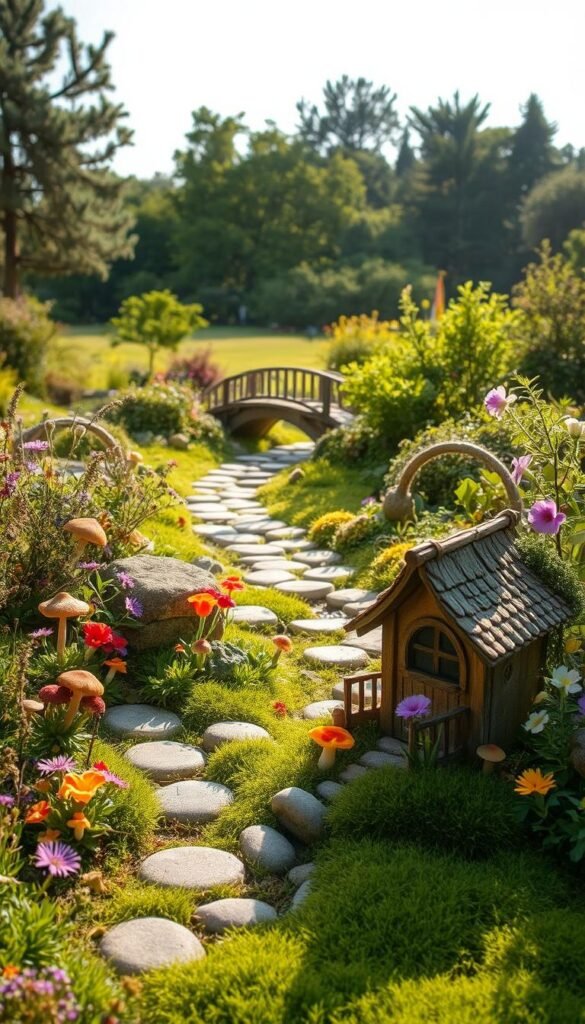Miniature landscapes filled with whimsy are taking backyards by storm. These tiny wonderlands blend nature and fantasy, inviting you to craft stories around delicate mushrooms, sparkling pebble paths, and charming figurines. Unlike small potted displays, expansive designs turn entire yards into immersive escapes where creativity knows no bounds.
Working with generous outdoor areas unlocks opportunities for layered designs. Imagine tiered hills with cascading flowers, hidden nooks for fairy cottages, or winding trails connecting themed zones. Larger spaces let you experiment with water features, elevated platforms, and natural materials like driftwood or stone.
These enchanted settings do more than beautify your property—they become living storybooks. Children chase fireflies near toadstool lanterns, while adults admire blooming groundcover that mimics magical forests. Every corner encourages exploration, whether you’re spotting tiny doorways in tree trunks or arranging seasonal decorations.
Successful projects start with vision and smart planning. We’ll walk through selecting plants that thrive in your climate, balancing open areas with detailed accents, and maintaining that sprinkle of magic year-round. Ready to transform ordinary green spaces into extraordinary realms?
Embracing the Magic of Fairy Gardens
Creating miniature worlds taps into our innate creativity and wonder. These tiny realms blend art and nature, offering a peaceful escape from daily routines. Whether arranging pebble paths or crafting tiny cottages, every detail invites you to slow down and reconnect with playful imagination.
Discovering the Allure of Miniature Landscapes
Working with small-scale designs offers surprising mental rewards. Studies show arranging tiny elements lowers stress by 34% compared to traditional gardening. The focused attention needed to place miniature bridges or moss carpets creates a natural meditation practice.
Children instinctively gravitate toward these spaces, inventing stories about fairy tea parties or hidden treasure hunts. Adults rediscover joy through seasonal updates—adding autumn leaves as fairy blankets or ice chips as winter ponds.
Finding Inspiration in Nature and Imagination
Look to fallen pinecones for rustic furniture ideas or use lichen as enchanted forests. Local parks and thrift stores become treasure troves for unique accents. One gardener turned an old birdbath into a sparkling fairy waterfall using recycled glass pieces.
| Design Element | Psychological Benefit | Creative Challenge |
|---|---|---|
| Mini pathways | Encourages mindfulness | Balancing scale & materials |
| Whimsical decor | Boosts mood through color | Weatherproofing delicate items |
| Living plants | Connects to growth cycles | Selecting climate-friendly species |
Neighbors often bond over shared projects, trading plant cuttings or handmade clay mushrooms. One community transformed a vacant lot into an interactive fairy village, proving these gardens build connections as easily as they spark smiles.
Benefits of a Large Fairy Garden in Your Outdoor Space
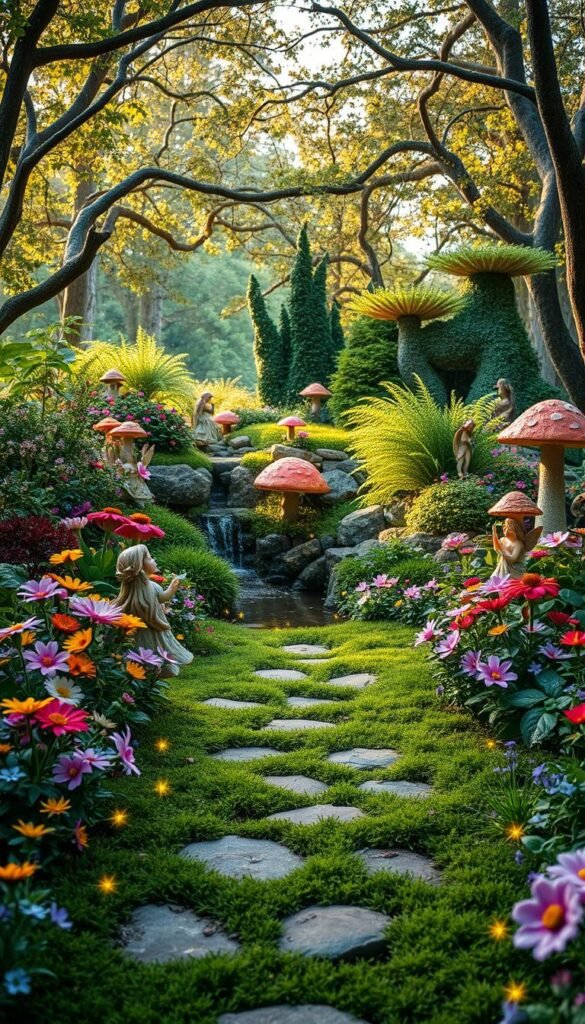
Transforming your property into an imaginative sanctuary offers more than visual charm—it creates lasting value. These playful landscapes turn underused areas into focal points that spark curiosity and connection.
Enhancing Your Yard with Whimsical Elements
Expansive designs turn tricky spots into charming features. Slopes become terraced villages with stone staircases, while shady corners host glowing mushroom clusters. Even poor soil areas thrive with moss gardens and drought-tolerant succulents arranged around tiny cottages.
Families gain outdoor classrooms where kids learn responsibility through watering miniature plants. Studies show children who help maintain green spaces develop 34% stronger environmental awareness. Seasonal updates—like swapping flower blooms or adding holiday-themed decor—keep the experience fresh year-round.
Unlike high-maintenance lawns, these spaces require minimal upkeep when designed thoughtfully. Groundcovers like creeping thyme suppress weeds naturally, while strategic stone paths reduce trampling. For more design inspiration, explore our guide to elevating your space with a gardening.
Neighbors often admire how these magical zones boost curb appeal. Real estate experts note unique landscape features can increase property values by up to 5%, making your yard both enchanting and economically smart.
How to Build a Large Fairy Garden in Wide Outdoor Spaces

Designing an enchanting landscape begins with smart preparation. Start by walking your yard to spot natural features that spark ideas—a gnarled tree root becomes a fairy cottage foundation, while a sloping area transforms into a cascading stream bed. Let these discoveries guide your vision.
Understanding the Project Scope
Map your space using colored flags to mark drainage patterns and sunlight zones. Sketch rough layouts that incorporate existing elements like rock formations or mature shrubs. A 10×15 ft area might host three themed zones connected by pebble trails, while smaller sections focus on detailed vignettes.
Consider maintenance needs early. Will you add stepping stones for access? Which plants thrive in your climate? Create a timeline that breaks tasks into weekend projects—week one for clearing debris, week two for installing pathways.
Setting the Stage for Creativity
Turn family brainstorming sessions into treasure hunts. Collect pinecones for furniture, smooth stones for bridges, or fallen branches for arches. One gardener used an old wagon wheel as a circular fairy garden centerpiece, surrounded by drought-resistant sedums.
Themes emerge naturally when you play with contrasts. Pair mossy ground covers with bright ceramic mushrooms, or arrange seashells around a miniature lighthouse for coastal charm. Leave room for spontaneous additions—kids often invent clever details like acorn cap birdbaths or leaf hammocks.
Gathering Essential Materials and Tools
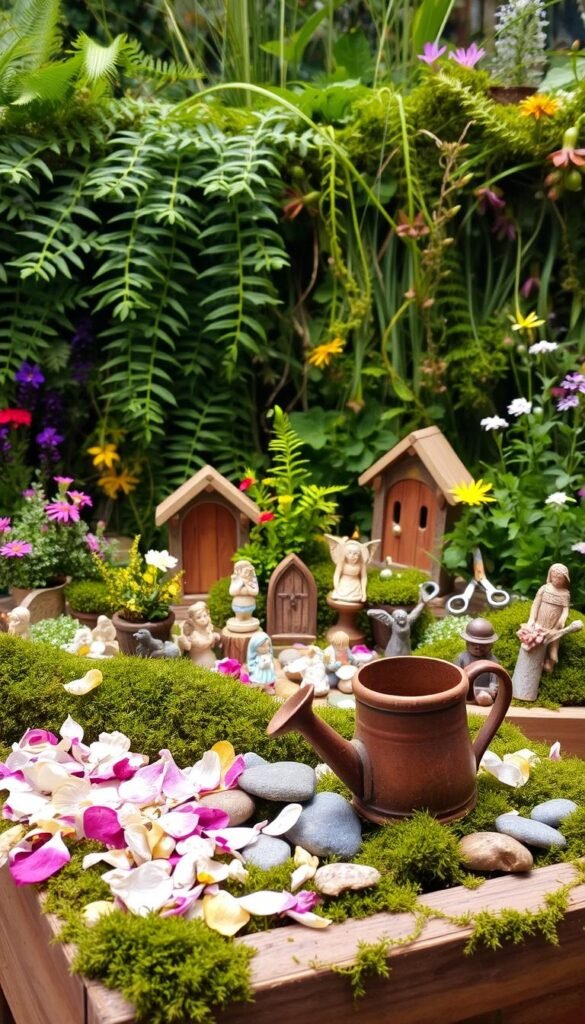
Assembling your toolkit transforms ordinary gardening into magical world-building. Start by raiding your shed for unused containers—chipped teacups, cracked birdbaths, or weathered wheelbarrows all make charming homes for tiny scenes. Natural elements like rocks and sticks add texture, while specialized soils ensure your plants thrive.
Selecting the Right Pot and Soil
Containers set the stage for your miniature ecosystems. Shallow pots work well for mossy clearings, while deeper ones accommodate root systems of dwarf shrubs. Repurpose broken clay pieces as stepping stones or retaining walls. Match soil to plant needs: cactus mix for succulents, moisture-retentive blends for ferns.
Choosing Miniatures and Natural Accents
Scour your yard for free decorations—acorn caps become bowls, flat stones transform into tables. For store-bought items, prioritize weather-resistant materials like resin or sealed wood. Dollar stores often carry tiny lanterns and ceramic animals perfect for populating your scenes.
Keep materials organized in labeled bins. Store delicate pieces in tackle boxes, and preserve bark decorations by sealing them with clear varnish. With the right supplies, you’ll create enchanting details that withstand rain, sun, and curious squirrels.
Step-by-Step Construction and Design Process
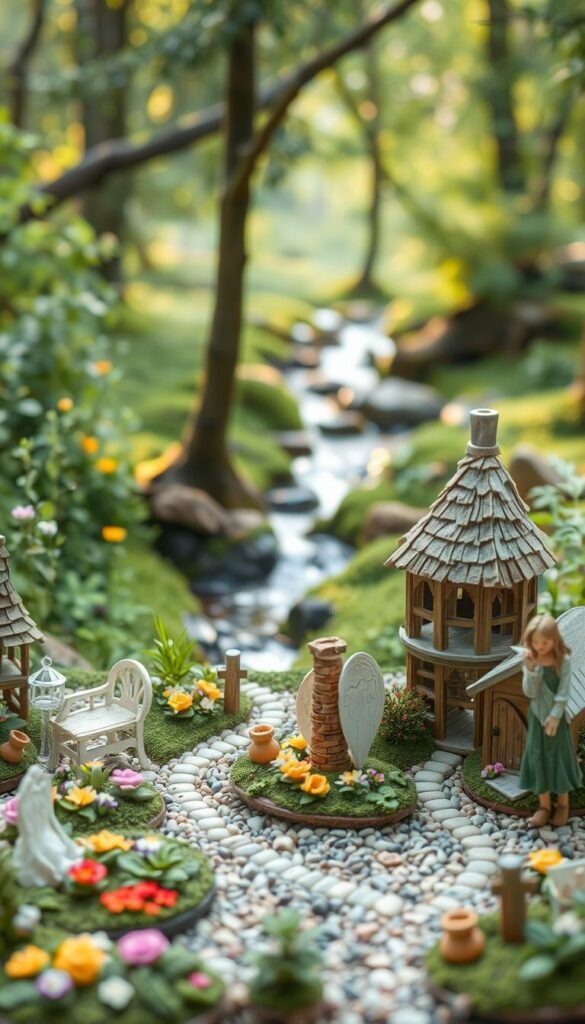
Transform your backyard into an enchanted realm through strategic layering and natural materials. Start by sketching your vision—mark areas for hills, water features, and gathering spots. This blueprint becomes your roadmap for bringing miniature magic to life.
Preparing Your Garden Base
Begin with potting soil mixed with perlite for drainage. For tiered designs, stack broken terracotta shards as retaining walls. Pack clay-rich dirt between layers to stabilize slopes. Test drainage by watering the base—puddles mean you need more sand or gravel.
Building Structures and Pathways
Create winding trails using crushed granite or moss strips. Set flat stones as stepping “stairs” between levels. “Paths guide the eye and feet through your story,” notes landscape designer Mara Thompson. Surround walkways with drought-resistant plants like creeping thyme or dwarf mondo grass.
Install tiny bridges over pebble streams, securing them with waterproof glue. Bury solar lights along routes for evening charm. Finish by tucking fairy cottages under shrub canopies, ensuring they’re visible yet protected from harsh full sun.
Injecting Creative Fairy Garden Ideas
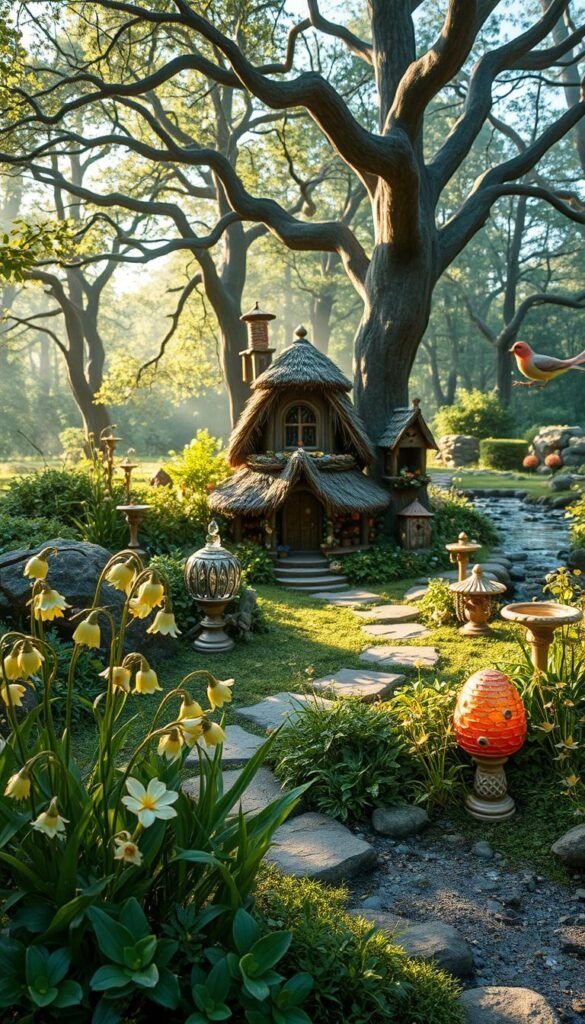
Breathing life into expansive landscapes starts with clever plant pairings and handmade magic. Blend living textures with playful accents to craft scenes that spark joy in every season. Let’s explore how to balance nature’s beauty with imaginative touches.
Choosing Plants and Miniatures for a Whimsical Touch
Mix succulents like echeveria and sedums with soft moss carpets for contrast. In shady zones, Irish moss and baby tears create velvety clearings perfect for tiny benches. Visit nurseries to find small-leafed varieties—miniature roses add pops of color, while creeping thyme releases fragrance when stepped on.
Arrange store-bought pieces from Hobby Lobby or Dollar Tree beside natural finds. A ceramic fairy door glued to a tree trunk becomes an instant focal point. Cluster miniature lanterns near flowering groundcover to guide visitors through your fairy garden ideas after dusk.
Incorporating DIY Elements and Recycled Materials
Turn broken teacups into bubbling fountains with waterproof pumps. Paint popsicle sticks as picket fences, then seal them with outdoor varnish. One gardener transformed wine corks into a charming bridge, secured with fishing line between two rocks.
Seasonal swaps keep designs fresh—press autumn leaves into resin coasters as fairy tables, or arrange pinecones as winter firewood stacks. “Recycled materials add character you can’t buy,” notes landscape artist Lena Cruz. Rotate accents monthly to maintain that just-discovered charm.
Keeping Your Fairy Garden Thriving
Maintaining your enchanted oasis requires balancing creativity with practical care. Regular pruning keeps plants from overshadowing delicate fairy-sized elements. Match greenery to your yard’s conditions—succulents thrive in full sun, while moss prefers shady nooks.
Maintenance Tips for Various Climates
Water small containers every 2-3 days during summer heat. In dry regions, mix water-retaining crystals into soil. Coastal areas benefit from salt-tolerant sedums, while snowy climates need frost-proof decorations.
Rotate resin miniatures to prevent sun fading. Wood accents age beautifully but apply sealant yearly. Replace overgrown plants with younger specimens to preserve scale. Combine annuals like lobelia with perennials such as dwarf hostas for constant color.
Seasonal refreshes keep magic alive. Add blooming pansies in spring or miniature pumpkins come fall. With thoughtful care, your fairy garden evolves into a lasting retreat that charms visitors for years.

